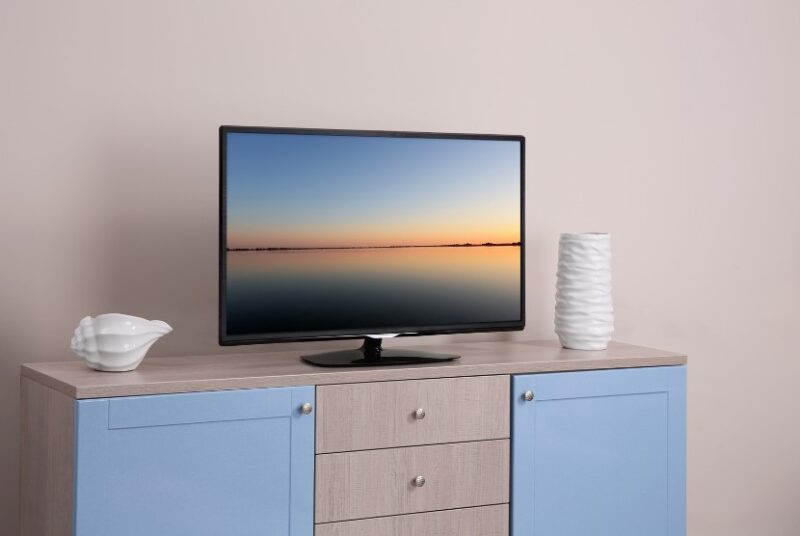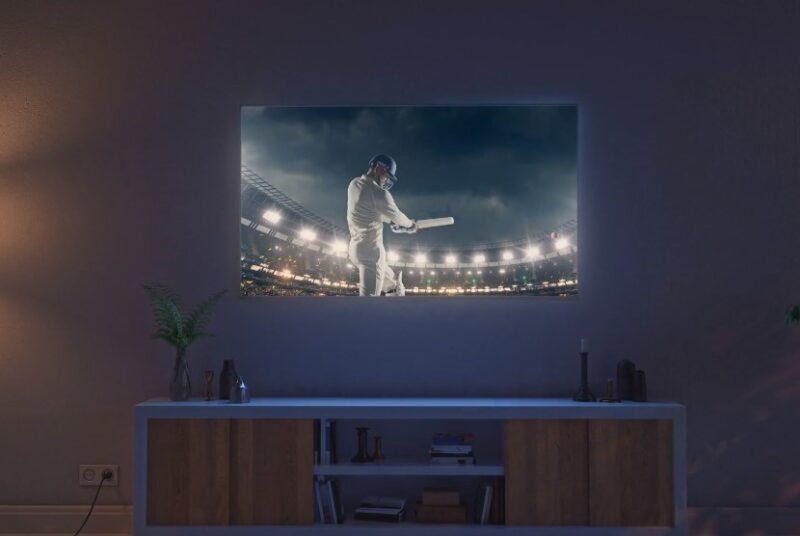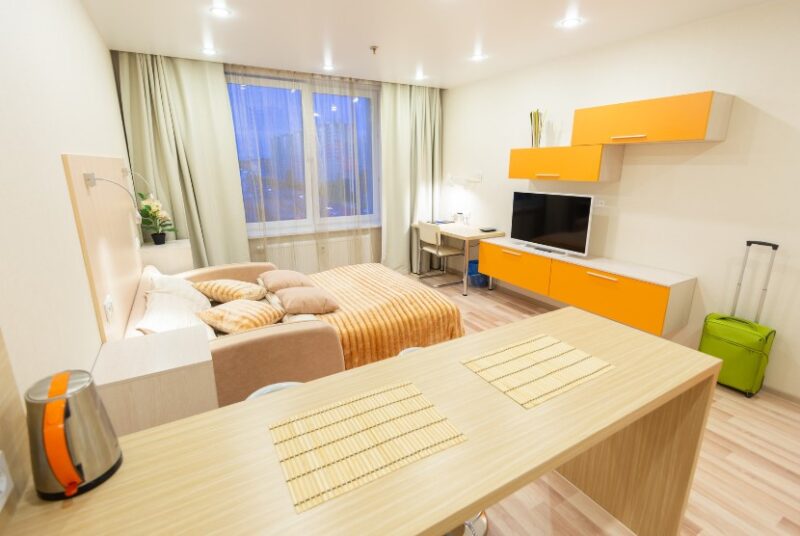When shopping for a new TV, it’s easy to be lured by the latest technology, massive screens, and ultra-thin designs. However, the reality is, the best TV for your room might not necessarily be the biggest or most advanced.
Size plays a pivotal role in ensuring the optimal viewing experience. In this comprehensive guide, we will discuss the ideal room size for a 32-inch television and why it matters.
TV Dimensions
Understanding the exact dimensions of a television, particularly when it’s described as a “32-inch TV”, requires an in-depth analysis of how these measurements are standardized and the implications they hold for consumers.
The Diagonal Measurement: Why It’s Used
The universally accepted convention for measuring TVs is the diagonal length. But why this particular approach? The diagonal offers a consistent standard, irrespective of changing aspect ratios.
As TVs transitioned from the older 4:3 format to the more widescreen 16:9 format, and even now to ultra-widescreen formats, the diagonal measurement has remained a constant, allowing for a more consistent comparison between different models and generations.
Screen Width and Height
While the diagonal measurement offers a useful shorthand, understanding the height and width of the screen provides a more detailed insight into how the TV will fit into a room.
For a 32-inch TV with a 16:9 aspect ratio, the width is approximately 27.9 inches, and the height is about 15.7 inches. However, these numbers may slightly vary based on the specific model and brand.
Bezels and Their Influence

The bezel refers to the frame around the display of the TV. Earlier models of TVs had thick bezels, which added considerable size to the overall dimensions. However, with the advent of modern design and technology, bezels have become much thinner, giving the illusion of an ‘edge-to-edge’ display.
It’s essential to note that when we refer to the “32-inch” specification, it pertains only to the screen size. The bezel will add to the TV’s overall dimensions, so always consider this when planning where to place or mount the TV.
Considering Depth: The Forgotten Dimension
While the focus is often on height, width, and the diagonal measurement, the depth of the TV – although significantly reduced in modern flat-screen TVs – still plays a role, especially when wall-mounting or ensuring stability on a stand.
Older CRT TVs had substantial depth, but contemporary LCD, LED, and OLED models boast slim profiles, often less than a couple of inches.
Viewing Distance Matters

Before identifying the ideal room size for a 32-inch TV, one must understand the concept of “viewing distance.” This is the distance between the TV and your typical seating position. The optimal viewing distance ensures that you can see all details clearly without straining your eyes or observing pixelation.
The general consensus among AV professionals is that the optimal viewing distance is approximately 1.5 to 2.5 times the screen’s diagonal length. For a 32-inch TV:
- Minimum recommended distance: 48 inches or 4 feet
- Maximum recommended distance: 80 inches or 6.67 feet
Room Dimensions
Given the above viewing distance, a 32-inch TV fits comfortably in a small to medium-sized room. Think bedrooms, dorm rooms, or a small apartment living room. This doesn’t mean it won’t work in a larger space, but in grander settings, the TV might seem dwarfed or leave viewers squinting.
Field of Vision
A significant factor in the viewing experience is ensuring the screen takes up the right amount of your field of vision. This idea complements viewing distance. In cinemas, for instance, screens are massive, but since they’re farther away, they take up a comfortable portion of your vision.
For home settings with a 32-inch TV, you want to make sure you’re seated in a position where the screen takes up enough of your visual field to be immersive without being overwhelming.
Resolution Impact

TV resolution refers to the number of pixels the screen has. Common resolutions include 720p (HD), 1080p (Full HD), and 4K (Ultra HD). For a 32-inch TV, the most common resolution is 720p or 1080p. Resolution and screen size work hand-in-hand to determine viewing quality.
A 4K 32-inch TV may offer a crispier picture at closer distances than a 720p of the same size. Yet, due to the limited screen size of a 32-inch TV, many argue the perceptible differences between 1080p and 4K are minimal unless viewed from extremely close ranges.
Considerations Beyond Size
While size is paramount, other factors influence the suitability of a 32-inch TV for your room:
- Room Layout: The layout might influence where you can place your TV and seating.
- Wall Mounting: Elevating the TV can help in rooms where the layout is challenging.
- Lighting: Too much glare can make even the best-sized TV hard to watch.
- Purpose: A secondary TV in a bedroom or kitchen has different demands than a primary living room set.
Evolution of Viewing Habits
Today, with the advent of mobile devices, our viewing habits are changing. Many are accustomed to watching on smaller screens like laptops, tablets, and phones. This shift means that some individuals may feel more comfortable with a smaller TV like a 32-inch even in slightly larger spaces.
The Aesthetics Factor

Lastly, aesthetics play a role. A massive TV in a small room might feel overwhelming, and conversely, a 32-inch TV in a vast space might appear out of place. Achieving a balance that complements the room’s décor and design is essential for many homeowners.
FAQs
Why is the TV measured diagonally and not horizontally or vertically?
The diagonal measurement of a TV provides a consistent standard that remains unaffected by varying aspect ratios. As TVs have evolved, the diagonal measurement allows for a direct comparison between different models and generations irrespective of their width-to-height ratios.
Do all 32-inch TVs have the same width and height?
Not necessarily. While a 16:9 aspect ratio 32-inch TV typically measures around 27.9 inches in width and 15.7 inches in height, the exact dimensions can vary based on the model, brand, and any unique design elements.
If I’m wall-mounting, should I be concerned about the depth of the TV?
Modern flat-screen TVs are usually slim, but it’s still essential to consider depth, especially if there’s limited space or if you’re aiming for a flush appearance. The TV’s depth and the wall mount’s design will determine how close to the wall your TV will sit.
Does the bezel size impact the quality of my viewing experience?
Bezel size is more of a design preference than a factor impacting viewing quality. However, thinner bezels can offer a more immersive viewing experience by reducing visual interruptions around the screen, giving the illusion of a floating display.
If the bezel doesn’t factor into the 32-inch measurement, how do I get the TV’s full size?
To determine the full size of the TV, including bezels, you’d need to refer to the product specifications provided by the manufacturer. They typically list the overall height, width, and depth of the TV, encompassing all design features.
How do older CRT TVs’ dimensions compare to modern flat screens?
Older CRT (Cathode Ray Tube) TVs were bulkier and had considerable depth compared to today’s flat screens. A 32-inch CRT would have a similar diagonal measurement but would be much deeper and generally have a larger bezel, making the overall dimensions bigger than contemporary models.
Conclusion
In essence, a 32-inch TV is versatile and apt for a variety of spaces, especially small to medium-sized rooms. While technical guidelines are a good starting point, personal preferences regarding aesthetics, viewing habits, and room design also influence the decision.
Always consider the room’s purpose and the viewer’s comfort when choosing a TV size. After all, it’s all about enjoying your favorite shows, movies, or games in the most immersive way possible.


